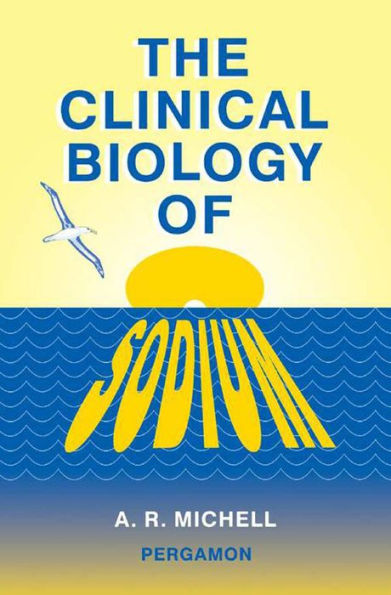5
1

The Clinical Biology of Sodium: The Physiology and Pathophysiology of Sodium in Mammals
388
by A. R. Michell
A. R. Michell

The Clinical Biology of Sodium: The Physiology and Pathophysiology of Sodium in Mammals
388
by A. R. Michell
A. R. Michell
eBook
$54.99
$72.95
Save 25%
Current price is $54.99, Original price is $72.95. You Save 25%.
Available on Compatible NOOK devices, the free NOOK App and in My Digital Library.
WANT A NOOK?
Explore Now
Related collections and offers
54.99
In Stock
Overview
The Clinical Biology of Sodium: The Physiology and Pathophysiology of Sodium in Mammals presents a comparative view of mammalian sodium regulation and its clinical disturbances. This book covers a wide range of topics, including the physiological basis of fluid therapy, oral rehydration for diarrhea, the pathogenesis of edema, hypovolemia, endocrine regulation and disturbances, and nutritional requirement. Organized into 12 chapters, this book begins with an overview of the distribution and physiological functions of sodium. This text then explores the two processes that provide the basis of most of the non-endocrine functions of the kidneys, namely, glomerular filtration and tubular reabsorption of sodium. Other chapters consider the avoidable human and material costs of hypertension. This book discusses as well the molecular biology of sodium transport. The final chapter deals with the three mechanisms capable of detecting changes in cardiovascular filling. This book is a valuable resource for doctors, nurses, and veterinarians.

Product Details
| ISBN-13: | 9781483100821 |
|---|---|
| Publisher: | Elsevier Science |
| Publication date: | 04/08/2014 |
| Sold by: | Barnes & Noble |
| Format: | eBook |
| Pages: | 388 |
| File size: | 3 MB |
Table of Contents
PrefaceIntroduction
1. Body Sodium in Context: Distribution, Functions and Regulation
Introduction: Some Problems in Context
Distribution and Concentration of Sodium
Basic Principles
Simple Disturbances
Oedema
Bone Sodium
Sodium in Brain and Cerebrospinal Fluid
Functions of Sodium
Sodium Transport: Na-K ATPase
Isoforms
Factors Affecting Activity
Na+-H+ Exchange
Conclusion
2. Renal Sodium Regulation
Introduction
Segmental Distribution of Sodium Reabsorption
Effects of Hypovolaemia
Endocrine Aspects of Renal Sodium Regulation
Glomerular Filtration
Ultrafiltration
Proximal Reabsorption
Loop of Henlé
Ascending Thick Limb
Regulation of ADH Release
Distal Nephron
Immaturity of Renal Function
Conclusion
3. Enteric Sodium Uptake
Introduction
Enteric Sodium Transport
Enteric Sodium Regulation
Enteric Responses to Changes in Sodium Balance
Diarrhoea
Oral Rehydration
Principles and Criteria of Efficacy
Amino Acids
Bicarbonate Precursors
Sodium
Sequestration: Third Space'
Iatrogenic Disturbances
Conclusion
4. Behavioural Regulation of Sodium Intake
General Issues
An Assumed Need, or a Real One?
Experimental Approaches
Early Studies of Salt Appetite
Studies in Sodium-Depleted Sheep
1. Neural Aspects
Taste
Hepatic Chemoreceptors
Other Brain Mechanisms
2. Humoral Aspects
Adrenal Hormones and Angiotensin
Reproductive Hormones
Other Hormones
3. Salt Appetite and Hypertension
4. Biological Role of Salt Appetite
Na, K and the Sodium Transport Hypothesis of Salt Appetite
Conclusion
5. Physiological Basis of Nutritional Requirement for Sodium
Introduction
Subjectivity, Science and Sodium Intake
Sodium Requirement and Normality, an Elusive Relationship
Attitudes, Beliefs and Prejudice
Definition of Requirement; Factorial, Empirical—and Pitfalls
Unmeasured Losses
Comparative Aspects of Sodium Requirement
Rats
Cats
Dogs
Ruminants, Horses and Pigs
Conclusion
6. Comparative Aspects of Salt and Hypertension
Introduction
What Matters about Hypertension?
Nutrition and Blood Pressure; Influences other than Sodium
Lipids and Fibre
Magnesium and Potassium
Calcium
Sodium and Possible Mechanisms of Hypertension
The Natriuretic Hormone (ASTI) Hypothesis
Effects of Hypertension on Fluids and Electrolytes
Pregnancy Hypertension
Salt and Human Hypertension
Comparative Aspects of Hypertension
Conclusion: Salt and Hypertension—Whose Decision?
7. Endocrine Effects on Normal and Abnormal Sodium Excretion
Introduction
Adrenal Steroids
Aldosterone: Regulation and Effects
Renin-Angiotensin System (RAS)
ANP
MSH
Kallikrein-Kinin System
Pregnancy
Haemodynamic Changes
Water Balance
Hormonal Changes
8. Clinical Aspects of Extracellular Volume and Sodium Concentration
Introduction
Sodium Depletion, Dehydration and Plasma Sodium
Sodium Excess: Hypertension and Oedema
Other Aspects of Abnormal Sodium Balance
Hypertonic, Hypotonic and Isotonic Dehydration
Isotonic Dehydration
Hypertonic Dehydration
Hypotonic Dehydration
1. Volume Excess
Oedema
Nephrotic Oedema
Hepatic Oedema
Cardiac Oedema
Chronic Obstructive Pulmonary Disease
2. Sodium Concentration: Hypernatraemia and Hyponatraemia
Hypernatraemia
Hyponatraemia
3. Volume Depletion
Anaesthesia and Surgery
Hypovolaemia and Shock
Adrenal Insufficiency (Addison's disease)
Heat and Exertion
4. Renal Dysfunction
Chronic Renal Failure
Acute Renal Failure (ARF)
9. Interactions Between Sodium, Potassium, Calcium and Magnesium
Introduction
Cellular Interactions
Renal Interactions
Physiological and Clinical Implications
Conclusion
10. Clinical Disturbances of Sodium Transport
Introduction
Cystic Fibrosis
Disorders of Muscle Excitation
Down's Syndrome: Alzheimer's Disease
Papillary Necrosis
Polycystic Kidney Disease
Gastric Cancer
Renal Tubular Acidosis (and Fanconi Syndrome)
Haemolytic Anaemia
Bartter's Syndrome
11. Drugs Affecting Sodium Transport and Sodium Balance
Diuretics
Osmotic Diuretics
Thiazides
Potassium-Sparing Diuretics
Loop Diuretics
Other Side Effects
Other Diuretics
Cardiac Glycosides
NSAIs
Other Drugs
12. Concluding Synthesis
References
Abbreviations
Index
From the B&N Reads Blog
Page 1 of
